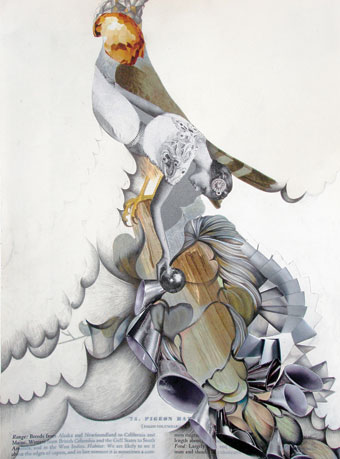Next story: Text transformed at UB's Center for the Arts
Balint Zsako, Esther Neisen, and Megan Greene at Buffalo Arts Studio
by Jack Foran



Myths, Insects, Embellishments
Artist Balint Zsako’s works could be categorized as “comic-erotic.” Which turns out to be pretty much of an oxymoron, a self-defeating proposition, at least on the erotic side. The comic aspect still holds up.
His drawings/paintings in ink and watercolor evoke or suggest myth stories known and unknown—in either case evincing the profligate pictorial and narrative imagination of the artist—usually regarding the ever-intriguing subject matter of sex, its dangers and delights.
Zsako is one of three artists on show in the current Buffalo Arts Studio exhibit. The others are Esther Neisen, who makes flying insect and insect habitat imagery from collaged bits and pieces of recycled photographic film negative, in a process that emulates the way these fauna make actual nests of bits and pieces of gleaned natural material, and Megan Greene, whose paintings/collages consist of extravagant embellishments of bird illustrations by previous more naturalistically oriented artists, such as John James Audubon.
One of the recognizable Zsako stories is that of Adam and Eve. There’s a tree and an apple and an invitation from the female of the two human figures, whose blatantly lascivious attitude makes it perfectly clear what more poignant temptations the apple is just a symbol of. The tree has lights, like a Christmas tree, as yet unlit, but Eve has hold of the switch. Moreover, the light string also encompasses a death figure, who will thus be illumined simultaneously with the tree of knowledge.
Another where I think I decipher the story seems to be about Trojan Paris’s fatal assignment to choose the most beautiful among three powerful (and vindictive) goddesses. Another recalls a typical academic art Roman orgy scene (wherein pornography posed as serious historical subject matter). Lots of naked nubililty and fruit.
But the majority of depictions and consequent narratives seem to be of the artist’s own idiosyncratic devising. Several feature remarkably complex multiple-actor scenarios more productive of (what would usually be considered) pain than (what would usually be considered) pleasure. (But not to attempt to prescribe or dictate regarding matters of individual taste and predilection.)
Several pieces make a connection between sexual and artistic creativity, featuring the phallus as an active artmaking appendage, by a variety of artistic techniques (but by whatever technique, the sexual organ seems to greatly outperform the painterly hand and brush)
Some of Esther Neisen’s flying insect depictions also include particular habitat structures—in one case a section of corrugated papery nest matrix material, in another a cross section of an egg incubation compartment, also illustrating the egg-deposition process—while others turn attention to human habitats, houses, and the idea of the insects as verminous invaders into people space, though really just pursuing their original purpose of species reproduction and survival, including fashioning habitat as they find opportunity. The supposed vermin were here before us. We’re the space invaders.
Some of the insects are in Petri dishes, like specimens, that are then diagrammed to locations in and around the house where the displayed specimens or their larvae were discovered, as if for a quasi-scientific study of what’s breeding where.
Occasional empty Petri dishes seem to indicate data gaps in the study. Possibly symbolizing gaps in the conceptual understructure of this art project. It’s not entirely clear just what’s on the artist’s mind with the project, what the artwork is ultimately trying to say or show about all these creatures and their habitats. There’s a sense about the project of more to come.
Megan Greene’s art seems to be a case of extreme gilding the lily. Birds in the natural environment and perhaps even more so in the exquisite artistic/scientific representations of Audubon and subsequent artists working the same avian illustrational territory constitute a showcase of the possible in terms of infinitely varied and variegated forms and colors and plumage adornment. Greene takes the Audubon and Audubon disciple artworks and further embellishes them with drawing and collage elements from more feathers to floral bouquets to swirl patterns of adventitious design elements of a basically baroque or rococo character. To the point of obscuring the original illustration often beyond recognition. We only know it was a bird picture by the printed legend listing common and species names and summary further information. Then hunt for any portion of the bird not covered up by the additional decorations.
So that what the artist ends up with are abstractions with redundant art historical references to several centuries of pre-modern artworks of every kind and quality, from the insipid (17th- and 18th-century Continental European wedding cake architectural excesses, Victorian ideas about décor) to the sublime (the music of J. S. Bach).
The three-artist show at Buffalo Arts Studio continues through March 10.
blog comments powered by Disqus|
Issue Navigation> Issue Index > v11n3 (Week of Thursday, January 19th) > Art Scene > Balint Zsako, Esther Neisen, and Megan Greene at Buffalo Arts Studio This Week's Issue • Artvoice Daily • Artvoice TV • Events Calendar • Classifieds |









 Current Issue
Current Issue